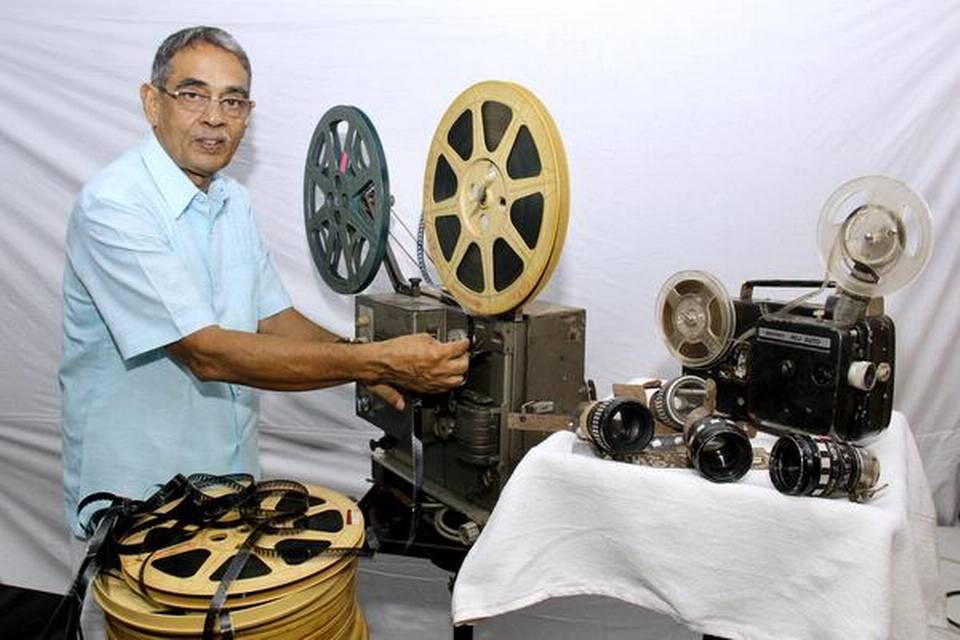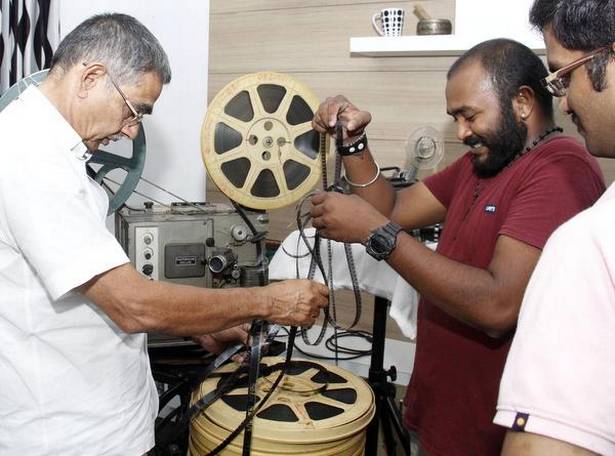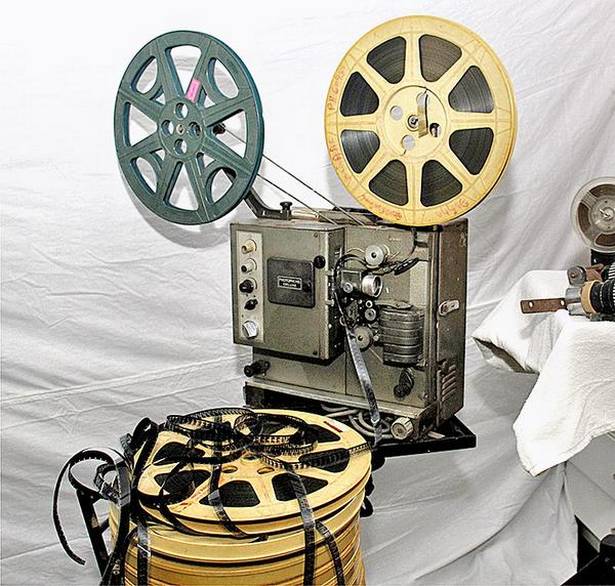Thrissur, KERALA :
With possibly the largest collection of Malayalam film prints, Poonam Rahim played a vital role in Kerala’s unique film distribution market
For those of us who grew up in the 70s and 80s, POONAM RAHIM 16 MM (and a telephone number) was a familiar sight, blazing out from all imaginable surfaces.
It was seen on crumbled walls, electric posts, sides of KSRTC buses and even on heaps of waste. And no one knew what the words meant.
Until they saw a 16 mm film screening at their local festival ground. The projector spluttering the light beam, which carried the images of Prem Nazir and Sheela and Sathyan and Sarada on to the white cloth stretched out in front. The name appeared on the print, ‘Contact Poonam Rahim for 16 mm projectors and film screening.’
It will not be hyperbole to say that it was Poonam Rahim, the Cinema Man of Thrissur, who brought cinema out into the open ground from the confines of the theatres. The 16 mm revolution that he had sparked off in Kerala during the 1970s created a unique distributing market for the films that is still very much alive. And, down the years, Rahim has become the owner of one of the largest collections of Malayalam film prints.
______________________________
- For advertisement- the stencil images- Rahim used to employ a team of four persons. They would travel on a jeep seeking out the dirtiest corners and junk heaps for painting the stencils. And the logic – “No one would bother to overwrite in such corners!”
- It was those stenciled ads which established his 16 mm projectors in the mindscape of Malayalis, Rahim believes.
______________________________
More than 400 original prints are stacked up along the shelves in his storehouse in Thrissur. Researchers on Malayalam cinema seek him out. Those who want to screen footage from the old black and white films also approach him. He provides footage of old films to be used in the production of new movies, like in Blessy’s Mammotty-starrer Kazhcha, that told the story of a 16 mm film operator.
And he can rattle off the complete history of Malayalam film industry right from the 60s in a jiffy. No wonder, as he was smitten by the film bug at a very young age.
Born in Kattoor, near Irinjalakuda in Thrissur district, Rahim’s school days were mostly spent lapping up the latest films that were released in Irinjalakuda’s two theatres – Pioneer and Konni. As his academic records plunged, the familypacked him off to his father who was running a provision store in Bhilai.
Rahim soon realised that he was not cut out to run a provision store. The world of films drew him on. And in no time the young boy formed a tie-up with the local distributor of Malayalam films. KT Abdulla was a relative of the famed producer TK Pareekutty of Chandrathara Films.
At first, the boy took the film boxes to cities like Korba, Chappa, Bilaspur, Jagdishpur and so on. Soon he started direct distribution rather than pay rent to Abdulla. And he named his enterprise as ‘Poonam Films.’ It was a random pick, as ‘Poonam’ was a popular name in North India.
As his very orthodox father never approved of cinema, Rahim was almost thrown out of the provision store.Rahim took a train to Chennai, the film capital of south India, armed only with the address of Bharat Film Corporation, one of the largest film distribution companies there. He had found the address on the film boxes.
Chennai did not open too many doors.
_____________________________
- In the 1900s, continuity of action across successive shots was achieved and the first close-up shot was introduced.Most films of this period were what came to be called “chase films.” The first feature length multi-reel film was a 1906 Australian production.
____________________________
Then Rahim had that life changing encounter, with a Marwari film distributor who offered the print and distribution rights in Kerala of Arappavan, the Sathyan-starrer Malayalam film directed by K Shankar. Paying ₹ 2,000 for the print and six posters along with the distribution rights for Kerala, Rahim boarded the train to Thrissur, where he had no contacts. Within no time, Rahim opened his office in Everest Hotel, which was a kind of hub for film distributors. Most of the rooms in that hotel were, however, rented by Kathaprasangam artistes, Rahim noticed, who would be camping there during their December – March season.
“Kathaprasangam artistes were stars in those days. Even average performers had a rate of ₹700 per show, while for stars like Aryad Gopi, it was ₹1000. I’d get a commission of ₹50.” Soon he became a full-fledged agent for Kathaprasangam.
Kathaprasangam quickly gave way to professional drama. “Drama was in high demand and the companies could not meet the demand. Often I’d to arrange two shows of the same play on the same day in different venues. Suppose the first show started at 8 pm, the second show would be scheduled at 10 pm. Naturally, the second show would be delayed as the troupe took time to travel. However, people would wait patiently as this was the only source entertainment available and was a big event. But we needed a stop-gap entertainment.”
It was into this vacant lot that Rahim brought in the film screenings. He offered free film screenings, which made both the organisers and the audience happy. Soon, Rahim purchased his first set of projectors. Janakshakti Films, a people’s venture into film production that had Left leanings, was on the verge of closing down and Rahim bought out their three projectors and 11 film prints for ₹30,000. The films included John Abraham’s Agraharathil Kazhuthai, PA Bakker’s Kabaninadi Chuvannappol, Ekakini, and some commercial hits like Kalliyankattu Neeli, and Ramanan.
Rahim used commercial hits for the festival grounds. Horror stories like that of Neeli, and the sentimental ones like Ramanan were big hits with the women. At a time when going to the theatre was a costly affair , these free screenings were quite successful. As the demand for the film screenings started to outdo that of drama, Rahim began to charge.
“Soon some 106 film operators sprang up all over Kerala. We would rent out prints to them, besides holding our own screenings. With the profits, I’d buy the next print,” Rahim recalled.
Slowly the nature of the entertainment industry changed. But Rahim was far-sighted and stepped in with the changing times. He started renting out the projectors, moving from 16 mm to overhead projectors and to LCD projectors, running one of Kerala’s leading projector rentals. He works with major festivals including the International Theatre Festival of Kerala (ITFoK).
At his Thrissur home is his precious collection of the projectors and various related equipment that Rahim takes out only for the benefit of the researchers. The rare collection of more than 400 film prints line up the shelves. “The last print I collected was that of Manassinakkare, he points out. And he does not have a website, or Facebook page. “People who need me, come in search of me,” says the 68-year-old quite confidently.
source: http://www.thehindu.com / The Hindu / Home> Entertainment> Movies / by Reun Ramanath / November 24th, 2018











